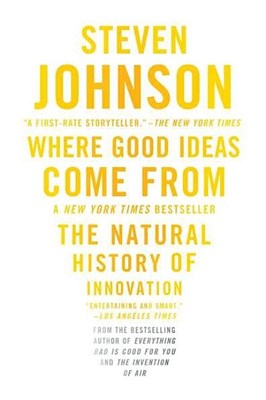Jack Covert Selects – Where Good Ideas Come From
October 15, 2010
Where Good Ideas Come From: The Natural History of Innovation by Steven Johnson, Riverhead Books, 326 Pages, $26. 95, Hardcover, October 2010, ISBN 9781594487712 Steven Johnson has written a brilliant analysis of creativity and innovation in his new book, Where Good Ideas Come From. It is no coincidence that this natural history opens with a story about Darwin, the most famous studier of origins.
Steven Johnson has written a brilliant analysis of creativity and innovation in his new book, Where Good Ideas Come From. It is no coincidence that this natural history opens with a story about Darwin, the most famous studier of origins. Similarly, Johnson is less interested in presenting a method on how to jumpstart our own ideas than in following the evolution and progress of ideas over time. How do ideas start? How do they grow? How do they become part of the fabric of our existence so that new ideas can be cut from that cloth? He begins to answer these questions almost as soon as the book begins:
If there is a single maxim that runs through this book's arguments, it is that we are often better served by connecting ideas than we are by protecting them. Like the free market itself, the case for restricting the flow of innovation has long been buttressed by appeals to the "natural" order of things. But the truth is, when one looks at innovation in nature and in culture, environments that build walls around good ideas tend to be less innovative in the long run than the open-ended environments. Good ideas may not want to be free, but they do want to connect, fuse, recombine. They want to reinvent themselves by crossing conceptual borders. They want to complete each other as much as they want to compete.But this book isn't just observational. Johnson lists seven patterns that help innovative thinking and structures his chapters accordingly. Through sometimes-unusual research and always interesting, intricate storytelling to back it up, Johnson reveals how innovation comes into being in many different shapes and sizes—and many times in counterintuitive ways.
For example, Johnson relays what Kevin Dunbar, a professor at McGill University in the '90s, found when he studied researchers at four leading molecular biology labs.
... Dunbar's study showed that those isolated eureka moments were rarities. Instead, most important ideas emerged during regular lab meetings, where a dozen or so researchers would gather and informally present and discuss their latest work. If you looked at the map of idea formation that Dunbar created, the ground zero of innovation was not the microscope. It was the conference table.Where Good Ideas Come From is a book that requires some investment from the reader because of the complex nature of idea creation and evolution, and the fact that Johnson digs deep into it. But the great research and engaging stories make that investment small compared to the rewards. This is one of the best books of the year.



